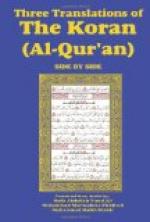of the Koran were in the first instance collected by
his immediate successor Abu Bekr, about a year after
the Prophet’s death, at the suggestion of Omar,
who foresaw that, as the Muslim warriors, whose memories
were the sole depositaries of large portions of the
revelations, died off or were slain, as had been the
case with many in the battle of Yemâma, A.H. 12, the
loss of the greater part, or even of the whole, was
imminent. Zaid Ibn Thâbit, a native of Medina,
and one of the Ansars, or helpers, who had been Muhammad’s
amanuensis, was the person fixed upon to carry out
the task, and we are told that he “gathered
together” the fragments of the Koran from every
quarter, “from date leaves and tablets of white
stone, and from the breasts of men."1 The copy thus
formed by Zaid probably remained in the possession
of Abu Bekr during the remainder of his brief caliphate,
who committed it to the custody of Haphsa, one of
Muhammad’s widows, and this text continued during
the ten years of Omar’s caliphate to be the standard.
In the copies made from it, various readings naturally
and necessarily sprung up; and these, under the caliphate
of Othman, led to such serious disputes between the
faithful, that it became necessary to interpose, and
in accordance with the warning of Hodzeifa, “to
stop the people, before they should differ regarding
their scriptures, as did the Jews and Christians."2
In accordance with this advice, Othman determined
to establish a text which should be the sole standard,
and entrusted the redaction to the Zaid already mentioned,
with whom he associated as colleagues, three, according
to others, twelve3 of the Koreisch, in order to secure
the purity of that Meccan idiom in which Muhammad
had spoken, should any occasions arise in which the
collators might have to decide upon various readings.
Copies of the text formed were thus forwarded to several
of the chief military stations in the new empire, and
all previously existing copies were committed to the
flames.
Zaid and his coadjutors, however, do not appear to
have arranged the materials which came into their
hands upon any system more definite than that of placing
the longest and best known Suras first, immediately
after the Fatthah, or opening chapter (the eighth
in this edition); although even this rule, artless
and unscientific as it is, has not been adhered to
with strictness. Anything approaching to a chronological
arrangement was entirely lost sight of. Late
Medina Suras are often placed before early Meccan Suras;
the short Suras at the end of the Koran are its earliest
portions; while, as will be seen from the notes, verses
of Meccan origin are to be found embedded in Medina
Suras, and verses promulged at Medina scattered up
and down in the Meccan Suras. It would seem as
if Zaid had to a great extent put his materials together
just as they came to hand, and often with entire disregard
to continuity of subject and uniformity of style.
The text, therefore, as hitherto arranged, necessarily




